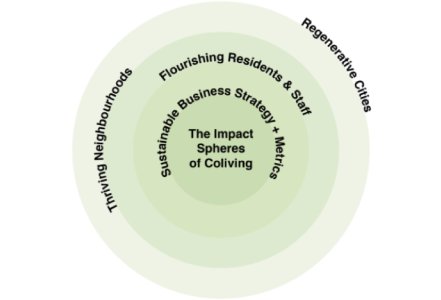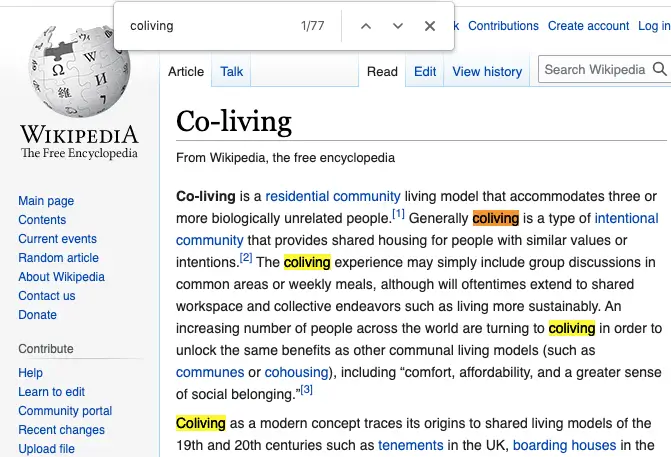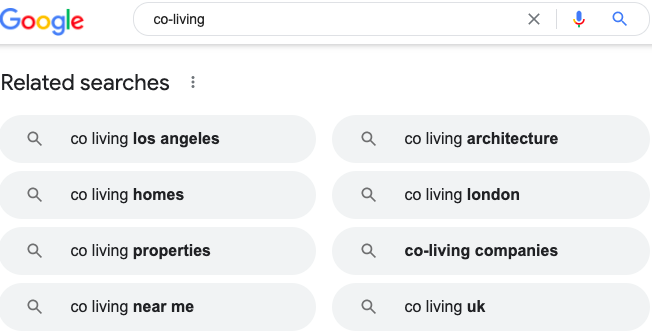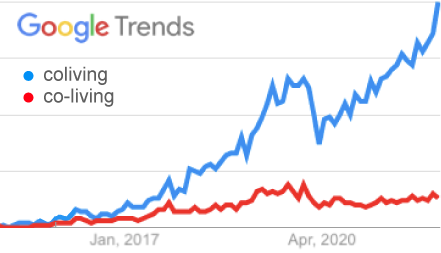Belonging. Convenience. Connection. Community. At the present time, these are some of the words most associated with coliving.
But what is coliving exactly? And what are its benefits for people, cities and the world?
On this page, you will learn about the potential of shared living and get a taste of coliving communities from every continent.
Also, find out about how to join, create, and optimise a shared living business. And of course, tune in to Coliving Conversations (Season 1) 🎙️ 🏠 💚 to explore much more.
So, let’s dive right in!
Section 1:
What is Coliving?
Coliving is a modern take on an old way of living in which people share resources, spaces, and experiences. Coliving can be defined as a group of unrelated people living together voluntarily in a housing-as-a-service space that has a community and convenience focus.
In short, “Housing-as-a-service”, or “home-as-a-service”, means the living space includes services to enhance the quality of the resident experience. To illustrate, aspects of coliving generally include
- Shared communal spaces and facilities such as lounges, kitchens, gym, gardens, laundrettes and more;
- Focus on community building and community facilitation;
- Convenience oriented lifestyle consisting of one fee which covers all bills, flexible contracts, easy sign-up, cleaning, WiFi, events and more;
- Private spaces typically made up of a bedroom and ensuite bathroom. Sometimes with a kitchenette or small living space;
- A professional team who manages operations in contrast to self-organised communities.
To this end, you can learn about 6 key benefits of coliving. What’s more, operators are selling a lifestyle and a set of beliefs about a better way to live (not just renting space). Indeed, in their “Coliving and the Common Good” report the RSA makes the clear distinction that:
unlike flat shares and other types of shared living arrangements,
coliving explicitly seeks to promote social contact and build community.”- The Royal Society for Arts, Manufactures and Commerce (The RSA)
All of the above helps form a general conception of coliving. However, in order to fulfill its full potential, coliving has to foster authentic connection to self, others, and nature.
The Global Coliving Movement (& the Pandemic)
Back in 2004, the term coliving first started to be mentioned. By 2016, it really picked up the pace. Drivers in the birth of the coliving industry include housing unaffordability, loneliness, urbanization, changing life patterns, and remote working.
In early 2020, the trend continued on the increase. And the pandemic hit all of us.
Of course, the Covid19 pandemic slowed down the upwards trend. However, we can see it is fully back on track now! In fact, the shared living industry is growing at a high rate to meet changing living demands. If you are curious about the latest market reports and trends, then visit the Coliving Research page.
Types of Coliving seen in the Market
One way to segment the shared living sector is by the type of residents that are part of the community. For example, in section 6 of this guide we explore:
Another way to view and segment coliving is by its similarities with other residential real estate asset classes. Some of these include: hospitality, purpose-built student accommodation (PBSA), build to rent (BTR) and serviced apartments. In section 4 you can read more on how coliving compares to other shared living typologies.
Business Model, Challenges & Viability
As can be seen, the number of coliving spaces around the world has continually increased. We have also seen many shared living businesses rise and then fall. Indeed, constant innovation and failure are to be expected in such a new industry. Specifically, some of the key challenges that coliving business models face include the following:
- Obtaining planning approvals
- Financial viability
- Multi-stakeholder engagement
- Proving the value of community
- Understanding corporate sustainability
Also, the viability of this new trend has been put to the test by the pandemic. To this end, industry expert Connor Moore shares that “operators that survive the pandemic will emerge with stronger and more financially sound business models. These will rely on fundamentals rather than magical valuation methodologies”. You can explore this further in the Coliving Business Model page.
"Co living", "Co-living" or "Coliving"?
If you are wondering whether to use “coliving” or “co-living”, then the Wikipedia article can generate more confusion than clarity.
On 17/2/2022, we captured some data. As we can see, the title of the Wikipedia page is “Co-living“.
But, the page mentions “coliving” 77 times. In contrast, the word “co-living” is used only 15 times.
What about “co living”? As can be seen, you will not find it on Wikipedia. In this case, the variant is generated by Google Search’s suggestions, not by real people.
Comparatively, Google Search comes up with “Coliving” about 3,290,000 results, “co-living” about 6,240,000 results and “co living” about 6,940,000 results. Thus, we can see that past content has used the version with hyphen much more. And, we see that the variant with a space has about the same number of results.
But, how people search for the term has clearly changed. When comparing the 2 main variations in Google Trends, it is clear that “coliving” is now the more popular way of searching and spelling it. But why?
As Gui Perdrix writes in his Medium article, the version without a hyphen is an easier term to use. In addition, Gui talks about the natural transition from “co-working” to “coworking”. Moreover, he estimates that around 80% of spaces are currently using “coliving”. We use the term without the hyphen as well. In sum, we encourage you to use the term ‘coliving’ without a hyphen! 🙂
How can Coliving Fulfill its Full Potential?
Overall, the sector has not reached its full potential in addressing loneliness, housing, consumption, and environmental crises. But we are on our way.
Back in 2017, a diverse group of professionals from different industries gathered in London to explore the topic of coliving. Not only were we all curious about this new trend, but we also felt confident about its growth trend.
Research made clear that much about modern urban life leaves people disconnected from themselves, from others, and from the natural world… with serious negative consequences. In comparison, we could see how coliving communities were providing an alternative way of living that facilitated true connection and thriving.
As such, we decided to create The Conscious Coliving Manifesto in order to support the development of:
shared living spaces that
genuinely foster connection with self, others, and nature
to pursue more meaningful, emotionally fulfilling, and sustainable lives
This open-source framework is designed to be shared and actionable. Key components include embedding wellbeing, community and sustainability into all aspects of coliving. This process is enabled by the pillars that underpin the Manifesto:
- Aligned policy and regulation
- Sustainable financial model
- Wise management and operations
- Supportive spatial design
The benefits and impact of coliving can be measured and optimised over time. But first, to gain a bit more perspective, let’s explore the benefits and potential of coliving.
Section 2:
The Benefits of Coliving
There are many benefits of coliving including: convenience, affordability, belonging, encouraging sustainable lifestyles, personal & professional development, and wellbeing. To illustrate, we discuss each of these benefits below.
Benefit #1: Convenience, Ease & Efficiency
Coliving spaces typically have an on-site operations and management teams that facilitate convenience for residents. For instance, operators often take care of maintenance issues, cleaning, postal services, and sometimes even food and beverage options. In addition, simplicity is achieved by charging only one fee for everything like: WiFi, utilities, rent, cleaning, and gym memberships.
Flexible contracts also make it easier for people to move in and settle down. For instance, most traditional rent contracts are set at 12 months minimum. With shared living, operators typically allow people to rent on a month-to-month basis.
Furthermore, life is made easier through the sharing of resources, knowledge, and skills. For example, residents of a coliving space can share cooking duties, borrow things, or lend a hand in times of need.
Benefit #2: Make Life More Affordable
More and more people are struggling to find affordable housing. Coliving reinvents the way we use space allowing for greater occupancy and more efficiency of resources.
Research into the US market found that coliving on average provides renters with a 30% discount to gross housing costs of traditional housing options in the same area, with similar results seen in several European cities. Indeed, this is a reason why urban coliving rooms are in such high demand and operators oftentimes have 95%+ occupancy rates.
Compared to a traditional single room rental option, coliving is relatively more cost effective. To illustrate, the fee you pay is not just for a bed and four walls. In contrast, it includes many of the services/amenities that you would otherwise pay extra for, such as cleaning and utilities.
Benefit #3: Tackle Loneliness
Loneliness is globally recognised as one of the most significant health concerns we face today. Indeed, it is often cited as being more harmful to your health than smoking 15 cigarettes a day. What’s more, loneliness was considered a pandemic even before Covid-19.
According to a study by Harvard, more than 1 in 3 adults in the US feel “serious loneliness.” Similarly, in the UK, loneliness is known as “the sad reality of modern life affecting over 9 million people.” According to a global survey, about 33% of adults experience feelings of loneliness worldwide and several governments have even appointed ministers of loneliness.
Coliving can help address this loneliness crisis through the sense of community and belonging that the lifestyle offers. MyTown in the Philippines is a great example. In a study, 64% of MyTown’s residents said living in their community made them less lonely. The World Economic Forum has also written about coliving as a way to ease anxiety and loneliness.
Benefit #4: Sustainable Living
Coliving can greatly reduce negative environmental impacts. Our Head of Research and Sustainability, Dr Penny Clark, found that a coliving community had emissions one third that of the average UK household. Another study found that living with others reduces a person’s environmental footprint by an average of 23%.
For the most part, these lowered impacts are enabled through the efficiency that comes with sharing spaces and resources. In addition, centralised or well-connected locations can facilitate sustainable travel. See our blog article on the inherent sustainable elements of coliving to read more on this topic.
Furthermore, tech can be an ally. For instance, smart sensors, modern methods of construction (MMC) and prefabrication are examples of tech solutions that support both operators and residents to live in a more sustainable way. To learn more about these technologies you can read Coliving Insights No.5: Co-Tech – Innovating Coliving with Technology,
Finally, coliving has a strong potential to spread and maintain sustainable norms and practices. See our blog article on creating sustainable cultures to find out more.
Benefit #5: Personal & Professional Development
Coliving spaces also offer a nurturing ground for personal and professional development. For instance, on the professional side, coworking is often included as part of a coliving package. In addition, networking opportunities are common. Furthermore, residents can regularly share and exchange skills/interests and may even co-create projects together.
In terms of personal development, residents of shared living spaces can develop and enhance things like emotional intelligence, spiritual practice, and creativity.
Coupled with this, conflicts that arise can be an opportunity for increased self-awareness and strengthened relationships. In particular, specific skills that can be developed include nonviolent communication, beginning anew, radical candor, and other conflict resolution skills. Check out the last section of The Community Facilitation Handbook for more practical tools in this area.
Benefit #6: Enhance Wellbeing
Wellbeing can be described as a set of building blocks that lead to a flourishing life. Particularly important to a flourishing life is having a sense of belonging and supportive relationships. Indeed, belonging is a basic human need, and good social relationships are the most consistent predictor of a happy life.
Shared living enhances wellbeing through community facilitation. Also, by fostering spaces where people feel part of a larger collective. Indeed, coliving can nudge people to take on healthy habits. For instance, operators can encourage residents to use the stairs, and offer things like gym memberships and discounts for natural and slow food.
Finally, coliving spaces can also foster wellbeing through spatial design. Examples of this include biophilic design, good air quality, natural light and circadian light systems, indoor plants, and vibrant use of color. To this end, The WELL Building Standard is a framework some coliving spaces are using to support wellbeing. Specifically, it includes aspects related to air, water, nourishment, light, fitness, sound, mind, materials, community and innovation.
Criticism of Coliving
While coliving has grown rapidly, it has also faced controversy and criticism. There have been concerns that coliving is simply a means to increase density and rental yields. In addition, it can be linked to the trend of gentrification.
Furthermore, in 2020 the Irish Housing Minister issued a ‘de facto ban’ on new coliving developments. Concerns included that they were becoming too numerous, were located too far from city centres, and could play a role in driving up land prices. Similarly, in 2020, another development in Manchester was halted due to concerns from local authorities about room sizes. In conclusion,
it is vital that we pay close attention to criticisms.
We must demand the best from the industry. In particular,
this means promoting authentic coliving, rather than faux-living!
What is faux-living? Make sure to check out the Faux-Living Manifesto!
Thus, it is also very important that we continue to educate policy makers, planners and developers on coliving. One key way to do this is by measuring and communicating the impact of this shared living industry. To that end, in the next section we explore the impact of coliving, how to measure it, and how to optimise it.
Section 3:
The Potential of Coliving for the World
The potential impact of coliving involves many layers and spheres of influence. These include the company, residents, local community and city/village/region levels.
Accordingly, we outline below the impact on each of these levels.
Also, you can read more about the different spheres of influence in our social value of coliving article.

Business Impact
Coliving can promote ethical business practice in several ways. These include:
- Building trust with consumers and suppliers. Here you can see how shared living brands are showcasing their impact;
- Attracting and retaining aligned employees and investors;
- Becoming certified by B Corps, a global network of companies that balance purpose with profit to build a more inclusive and sustainable economy.
Coliving Residents & Team Members
The impact that shared living can have on residents and staff is significant. To summarise from Section 2, these include:
- Tackling loneliness through social connection;
- Making life more affordable through cost effective measures;
- Personal and professional growth through opportunities to learn and exchange with others;
- Enhanced individual and collective wellbeing through an increased sense of belonging and connection;
- Easier and more efficient lifestyle as community members share resources, knowledge and skills.
Coliving and Neighborhoods
At the local neighborhood level, coliving has the potential to:
- Create local jobs;
- Become neighbourhood hubs that exchange, deliver and contribute a multitude of different ‘community capitals’, such as economic, social, cultural, human, natural and political capital;
- Serve as a creativity hub for artists, musicians, and other creatives to share and develop their talents through curated events and activities;
- Boost local entrepreneurship through partnerships and networking;
- Enhance local environmental sustainability through volunteer activities, community gardens, sustainable transport and emissions measurement.
To illustrate, reports such as the The Social Hub’s impact reports highlight the positive impact of coliving at the local level.
Coliving and Cities, Regions & Nations
At the city, regional, and national level, coliving has the potential to:
- Help make the 15 minute city model a reality by making housing and other basic services close to one another;
- Advance cities towards meeting their sustainability goals through sharing of resources, urban layout, sustainable travel options, and measuring emissions;
- Support the public health care system and public services to care for the elderly through senior and multi generational coliving;
- Reduce the negative impact of the loneliness pandemic.
Indeed, the impact of coliving can spread through local neighborhoods. And, eventually have an impact on wider policies at the city, regional and country level.
Coliving and the World
The coliving industry also has the potential to support the planet and meet some of the UN’s Sustainable Development Goals. They are perhaps the most recognised impact-related goals in the world.
In brief, these 17 goals were agreed upon in 2015 by 193 countries. But, why are they so important? They are designed to tackle the world’s greatest challenges by achieving a better and more sustainable future by 2030. Each of these goals breaks down into further sub goals and targets.
Coliving can help countries meet targets under:
While she was at UN Women, our co-founder Naima helped integrate gender-responsive indicators into the SDG targets. Thus, we are familiar with the goals and the potential of coliving to help meet them. For instance, learn about coliving and climate action in the COP26 article.
Nonetheless, there is a challenge shared by all within the industry: how to measure and optimise impact, sustainability and social value? Without a doubt, we must hold this question over the years ahead, as we develop the answers together.
Measure & Optimise Coliving's Impact
Over the last few years, Conscious Coliving has been researching how to measure the impact of shared living businesses. We recently recorded a webinar entitled ‘Embedding ESG & Social Value in Shared Living‘, which can help you get started on your impact journey, and feel grounded in how to think about ESG & social value in relation to your shared living business.
We have also been exploring the development of The Coliving Impact Framework, a tool that ultimately can be used to measure the impact of coliving businesses across a variety of areas. Some of these are sustainability, wellbeing, and community.
This framework will include a ‘Social Value Metrics Database’ with indicators from existing frameworks. Some of these are the UN Sustainable Development Goals, GIIN, One Planet Living Framework, and the GoodHome Report. Indeed, our research shows that:
embedding ESG (environmental, social, and governance)
and Social Value (social, environmental and economic impact)
has many benefits for shared living businesses
In addition, it is becoming increasingly important to investors, cities, team members and consumers. Curious? Then learn how to harness the power of impact and sustainability.
Section 4:
The Evolution of Shared Living
History of Communal Living
Living communally is nothing new. As a species, humans have evolved to be social. Indeed,
for 99% of our existence,
we have lived, worked, played and died
in groups of 20 or more individuals.
Communal living and sharing resources can be traced back to the hunter gatherer societies. These societies were based on common ownership and equal social relations. Humans lived in large, mobile tribes, relying on one another for everything from food to protection to child care assistance.
During the middle ages, communal living remained the typical household structure across most of Europe, consisting of friends and extended family. As the start of 12th century, households started becoming more organised around monogamous couples and their children. But, communal housing was still common.
It was not until the Industrial Revolution of the 1800s that the communal way of living was disrupted. Before then, most of the British population lived in rural areas. By 1900, 85% lived in growing towns or cities.
The rural exodus pushed poor people into crowded and dirty ghettos, while the wealthy lived in private homes. Thus, in many growing cities, privacy became valued over communal and shared homes.
This trend would follow in the rest of the world. While productivity and GDP began to grow, human and planetary wellbeing began to decline. Since then, various forms of shared living have emerged as a response to changing social and economic factors.
Below we share a few.
Boarding Houses
In nineteenth century USA, boarding houses – homes with several lodgers and live-in landlords and landladies – were commonplace. Usually they were privately run, but large and professionally owned establishments also existed. For example, Chicago’s Eleanor Clubs were designed to house the many young women flocking to the city to work.
In most boarding houses, residents shared dining and living spaces. Hence, they were a haven for those new to the city and seeking social ties, especially immigrants. Boarding houses are an example of shared living that sprang up when lots of young professionals moved to cities to work. Undeniably, this is similar to the trend today.
Flatshares and House Shares
Flat and house sharing became popular as more and more people moved to cities. While originally, this was to save costs, there has been a rise in higher earners choosing to flatshare. Key drivers for this include convenience, social life and ability to afford ‘nicer’ housing.
In short, the popularity of flatsharing reflects our changing attitudes, with shared space becoming normalised and even desirable to many.
Hacker Houses
Hacker houses boomed around 2013 in expensive cities where budding tech entrepreneurs decided to share space. Indeed, this allowed them to save on rent and boost their career opportunities through coworking, socialising and sharing meals.
Many say that coliving evolved in large part from hacker houses. Take for example HubHaus, which originated from the concept of the Hacker House. In addition, many coliving schemes are designed to appeal to digital nomads and freelancers who need places to work and live. For example, Smena Station, ReStation and Zoku are all aimed at digital nomads.
Finally, the idea of hacker houses have evolved into ‘content houses’ where Gen-Z influencers live and create videos for social media platforms. Examples include The Hype House (which will have its own Netflix show soon) and Sway House, amongst dozens more.
Purpose-Built Student Accommodation (PBSA)
PBSA, or purpose-built student accommodation is housing that has been built for university students. Specifically, PBSA is typically made up of 50+ units in the form of studios or ‘clusters’ (several bedrooms which share a kitchen and living space). Generally, there is an emphasis on communal spaces. Indeed, PBSA can be seen as a cousin to the modern form of coliving. Arguably, this housing typology normalises living communally for future potential coliving residents.
While universities still own the majority of PBSA (69%), private companies are quickly increasing their share due to high demand for student living options. Markedly, ESG factors are increasingly influencing the development of the PBSA sector. Indeed, students are some of the most motivated in tackling climate change and pushing for decarbonisation.
Read more about how to harness the power of ESG for PBSA.
Intentional Communities / Cohousing
An intentional community can be defined as a group of people who have chosen to live together with a common purpose that reflects their shared core values. The ethos of these communities often reflects the issues of their time. For example, many intentional communities now have an ecological focus.
Housing cooperatives, ecovillages, and cohousing are the most popular types of intentional communities listed in the Communities Directory Book.
Platforms related to intentional communities include The Foundation for Intentional Community (FIC), Global Ecovillage Network (GEN), Diggers & Dreamers, re:build, Rural Shakers, ReGen Villages and NuMundo.
Others
There are many other types of shared living models that we could mention. For instance, these include pop-up coliving (such as Karisma), hybrid models, care homes, kibbutzes and more.
Feel free to write to us with other examples you know of and/or have experience with. This page will evolve over time. 🙂
Section 5:
Coliving Communities Around the World
In the section below, we offer an overview of the trends in coliving around different parts of the world. In addition, we highlight some spaces that align with a more impact-oriented and conscious approach.
Coliving in North America
Most coliving companies in North America are concentrated in large and expensive cities such as Los Angeles, NYC, Chicago and San Francisco.
In addition, research by CBRE from 2020 shows that expansion plans include coastal markets plus secondary cities like Atlanta, Austin, and Denver. Some of the largest operators in the US include Common, Outpost Club, Outsite, and Venn.

Meanwhile, some brands in Canada include Gather, Sonder, and Nomad. In Mexico, there are over 13 coliving companies already in operation. We particularly like the following communities in North America, for their focus on positive impact:
- Treehouse: Located in Los Angeles with a biodynamic approach to living including a resident cafe, rooftop, dining hall, art studio, library, music studio, lounge, and of course, a tree house! It consists of an apartment building with 5 bedroom, 3 bedroom and studio options.
- Haven: Wellness community with two locations in Venice Beach, Los Angeles. The space supports living with intention and practising together. Facilities include a gym, yoga studio, co-working, courtyard, rooftop deck, and spaces for creative events.
- OpenDoor: over 15 fully furnished shared homes across San Francisco, Berkely, Oakland, Portland, and Seattle. Its mission is to enable members to live with greater connection, creativity, and sense of purpose.
- Covive: 12 houses in Mexico City that inspire people to live in harmony through shared values, community design, and living agreements. Residents form part of a network that offers shared spaces, events, trips, and more.
- Embassy Network: 8 locations across USA and Canada, as well as 4 on other continents. It is a network of place-based communities experimenting with new forms of governance and solidarity.
Coliving in Europe
According to research by ULI and JLL, there 24,500 operational coliving units (20 beds or more) in Europe as of the second quarter of 2022, with a further 70,500 in the pipeline (planned and under construction) across 17 different countries.
Indeed, the report shows that the biggest markets in Europe are the UK, France, Netherlands, Germany and Spain.

London alone holds 20% of the European market share. A study by Catalyst reports that 48% of single people in London find traditional housing rent expensive. Many are willing to exchange private spaces for a good location, convenience and access to amenities. Furthermore, the Greater London Authority has recently identified coliving as an alternative form of housing to meet the high demand for student housing and has developed a planning policy for Large Scale Purpose-built Shared Living (LSPBSL) accordingly.
Some of the impact-oriented shared living spaces in Europe are as follows:
- Citylifer: a Rotterdam based series of smart and affordable coliving spaces tailored to the needs of young adults to live better together
- Colive: a Sweden based coliving space offering a digital roomie matching tool and community focus
- 20-30: Sustainability focused community based in Sweden
- The Social Hub: Hybrid model of shared living, coworking, and event space with several locations throughout Europe
- Mokrin House: Rural coworking and coliving in northern Serbia
- Coconat: Workation retreat space nestled in nature outside of Berlin
- POHA House: Range of houses addressing loneliness and sustainability in Germany
- Sende: Rural coworking and coliving space in Northern Spain
- Mason & Fifth: Wellbeing-focused coliving in London
- Noiascape: Network of serviced living spaces in London
- Rooral: Regenerative and community based shared living in rural Pyrenees and Andalusia
- The Cohesion: ‘United residential communities’ in The Netherlands
- Folk: one of the UK’s leading coliving brands, with their first community in Harrow
- Ariv: Switzerland’s newest coliving community, with their first site located in Basel
- Neybor: a new boutique coliving brand in Brussels, Belgium
- &soul: a new London-based coliving operator that builds soulful spaces that nurture individuals, empower communities, and awaken change
- Selgars: a rural coliving community in Devon that hosts team building offsites, weddings, wellness retreats, community gatherings and educational programs
Coliving in Central & South America
Coliving is expanding throughout Central and South America. For example, Casa Campus the biggest company in the region, is expanding across several cities including Buenos Aires and Lima.
In addition, our friends at Oka have several spaces in Brasil and were one of the first shared living spaces in South America. Furthermore, Selina offers a month-by-month program across many cities across the region.

Other smaller, impact oriented communities include:
- Kusi Sacha: Self described as the first ‘ecoliving’ in Lima, Peru
- OPTA: Based in Uruguay with a focus on wellbeing
- Tabula Rasa: Based in Bogota, Colombia with a strong emphasis on community
- ZAG: Community and creativity-focused shared living in Uruguay
- Las Campanas: Nature-oriented coliving space in Uruguay
- Stolas: Sustainability and community centric space in San Jose, Costa Rica
- Yuca: Housing-as-a-service startup based in São Paulo, Brazil
- Covive: Mexican smart living in Monterrey NL and CDMX
Coliving in Asia
Coliving is growing fast in Asia. Chinese operator You+ provides housing to over 10,000 people across 25 branches. In Beijing, shared living spaces are popping up in districts where top universities are located.
India is home to over 50 coliving companies and Hmlet and Dash Living also offer a range of shared living options in Hong Kong, Singapore, and Tokyo.

Indeed, coliving is becoming a popular choice in Asia for students and young professionals working in tech and creative industries. Impact-oriented spaces in Asia include the following:
- Tanehu: Rural community in Japan that offers residents a chance to experience local culture and lifestyle
- MyTown: Phillipines-based coliving operator and winner of the 2021 ‘Impact & Sustainability’ Coliving Awards category
- Episode: Developer and operator based in South Korea, who won ‘Coliving Operator of the Year’ in the 2021 Coliving Awards
- Gnomadic: Personal growth, sustainability, and community-oriented space in Singapore
- The Hatchery Place: Self described “hatching place for creators’ based in Malaysia. They hold regular events to cultivate a creative co-learning lifestyle
- Zolostays: India’s largest coliving platform
Coliving in Africa
The coliving trend is not so present in Africa yet, but there is a lot of potential. One big issue that shared living can address is access to housing.
For instance in Kenya, many young professionals work in the business center of Nairobi but can currently only afford to rent places far outside the city center. This means a lot of time and money wasted on commuting and the need for affordable options in more central locations.

Several players are stepping in to develop housing for young African professionals and digital nomads. These include:
- The Vlage: Upcoming Kenya company offering affordable housing and coliving services in Nairobi
- Haap Living: A shared housing company based in Nigeria
- Noma Collective: remote working retreats for digital nomads with pop up coliving experiences in beautiful destinations like Watamu, Kenya.
- Neighbourgood: Perhaps the most developed option in Africa right now. Located in South Africa, it describes itself as a community centered space. Thus, the brand offers a fully connected living experience that integrates accessibility and freedom
Coliving in Oceania
Places like Bali have become a hot spot for coliving. For instance, Outsite and Outpost have spaces there. Australia was a bit slow to pick on the trend due a high home ownership culture. But recently, an increase in renting is giving rise to more coliving.
For instance, Dash Living now runs and is expanding the coliving operations formerly operated by Hmlet in Australia.

Impact-focused shared living operators in the region include:
- Together: Based in Melbourne Australia and focused on community with monthly events
- UKO: Chain of coliving spaces in Syndey with Community Hosts and regular community activities
- The Onion Collective: Space in Bali geared towards mindful living and offering coworking and coliving for people to connect, play, and co-create
- Dojo: Coliving and coworking spot in Bali with social impact focus
Section 6:
Who is Coliving For? And Examples
Certainly, coliving can be for everyone. But, there is no doubt that the global movement has been driven by a few demographics. Hence, we explore who coliving is currently aimed at.
Coliving for Digital Nomads & Remote Workers
Digital nomads are people who can work from different places and so choose to travel and work. Firstly, they want to remain geographically flexible. Secondly, they want to have a social network. And thirdly, a place that feels like home.
In particular, about 51% of Digital Nomads choose to live in hostels. Evidently, coliving offers an ideal solution for digital nomads: flexibility and social life with more homeliness than a hotel or hostel. There are even many networks for modern nomads to connect on, including NomadX, MINOMA (formerly Borderless Retreat) and The Nomad Escape. In short, examples of nomad community spaces include:
- Sun & Co: A space in Javea, Spain for up to 20 remote workers. The mission is to foster personal and professional growth. Residents can hike, surf, snorkel and/or join skillshares and masterminds.
- Coconat: A workation place outside of Berlin, Germany for doing concentrated work in nature. Residents can choose to be in solitude or join for family lunches and dinners.
- Palma Coliving: offers handpicked villa-style properties in premium locations near the sea in order to create vibrant digital nomad communities. Palma Coliving was founded in 2020 to support remote workers by providing them with premium places to live, work and grow.
- Arctic Coworking Lodge: A lodge equipped with 10 desks, 2 meeting rooms, monitors and superfast wifi. Based in the Lofoten Islands of Norway, residents often hike, surf, climb and sit around bonfires.
- PortusHome: a remote coliving and coworking hub located in Vászoly, an idyllic village near Lake Balaton in Hungary. PortusHome is a meeting point, a place for events for like-minded people, where nomads can enjoy the rural Balaton region by bike, by foot or on the water.
- Outsite: Founded to serve location flexible professionals. They offer a range of stay options in USA, Europe, Latin America, Asia as well as an online Member Hub. They plant a tree for every booking made with 5455+ trees planted so far!
Coliving for Urban Dwellers
Many coliving operations are based in large cities. They target city dwellers that value a convenient, community centric, and cost-effective lifestyle. In particular, young professionals are often attracted to urban spaces that offer networking and connection opportunities. Some urban locations include:
Coliving for Students
Students are among the most common resident types and for good reason. For them, coliving offers affordability, flexibility and a direct integration to the community. All this, while being able to keep very independent lifestyles and explore the locations where they study.
So, what is the potential? At this time, a large portion of people who live in coliving are students. According to Cushman & Wakefield’s report, there are now over 681,000 student accommodation beds across the UK alone. Moreover, JLL’s article states that “there’s no doubt there’s a demand out there and the economics of it are pretty obvious”. But, not all student housing brands can be described as coliving. To illustrate, student examples include:
Coliving for Entrepreneurs
This takes us back to one of the origins of coliving: San Francisco hacker houses. Entrepreneurs live together in a supportive environment that can offer residents social, emotional and practical, support. And, it can also be helpful for networking. In fact, many operators run workshops, masterminds and pitch practices.
Thus, these spaces help to launch residents towards business success. Some examples include:
- Draper Startup House: Many locations
- HackerHouse: Paris, France
- Startup Embassy: Silicon Valley, United States
Coliving for Seniors
An under-explored but much-discussed group for coliving is seniors. We know from research that loneliness can have negative impacts on health and wellbeing. Indeed, a recent report by the Cambridge Centre for Housing and Planning Research discusses the potential benefits of coliving for senior wellbeing. Basically, the social and practical support offered by these communities may mean that seniors can improve their quality of life, and maintain (co)independence for longer.
Coliving is also being aimed at those who are middle-aged who perhaps prefer to live more centrally and sociably. Some examples include:
- The Embassies: Europe
- Plushusene (by NREP): Denmark
- Umanti: France
Coliving for Families
Currently, most models are not ideal for families. However, notable exceptions exist. We see huge potential for homes which provide a support network for busy parents. To illustrate, a few family-oriented examples include:
- Commune: Paris, France
- ShareAbode: Australia
- Cohabs: Belgium
Others
The above mentioned list is by no means complete. As a matter of fact, coliving can also cater to artists, volunteers, travelers, and people who want to live inter-generationally. If you know of any other specific communities we could include, please let us know!
Section 7:
What's Next in Your Coliving Journey?
So, what’s next for you? Surely, it depends on who you are and what you are after 🙂. Whether you are considering your next personal or professional move, we hope this guide is helpful. To that end, here are some next step options for you:
Join a Coliving Community
If you made it all the way to the bottom of this guide, then coliving might be the next move for you. As has been noted, the benefits of coliving are many. Also, there are wonderful teams running most of these shared living businesses. Thus, these communities can be not only a lovely place to live, but also a great place to work.
If you are curious, then go ahead and find your coliving community.
Create & Optimise Coliving Communities
Whether you are a team member at a big real estate developer, or part of a small start-up, innovating can feel overwhelming. Luckily, there are many passionate organisations and individuals here to support you, including us at Conscious Coliving and our partners.
To begin with, make sure to explore existing coliving resources. Over the past years, our partners, industry players and ourselves have created useful content in many formats. Here we highlight some of our key resources:
- The Community Facilitation Handbook: Co-created by 3 authors and 16 contributors. This award-winning holistic framework enhances resident engagement and satisfaction. In short, learn the dos and don’ts of community facilitation.
- Coliving Apps, Software & Tech Guide: All in all, this guide makes a complex topic simple. 60+ tech solutions that support operators create thriving resident and community experiences.
Also, we are here to support you with further education, as well as bespoke support.
Keep Learning about Coliving & its Impact
Without a doubt, challenges and confusion will continue to emerge as the coliving movement grows. At the same time, there is lots of room for opportunity, learning and excitement!
We invite you to tune in to Coliving Conversations podcast episodes! 🎙️ 🏠 💚. Season 1 of the show offers 7 episodes that shine a light on people, projects and places giving rise to the coliving sector. In addition, you can explore the coliving blog articles and subscribe to The Conscious Coliving Newsletter.
Until next time, we wish you all the best on your shared living journey!
~ Penny, Naima, Matt & Juan
This article has been coauthored for you by:
Penny is Director of Research & Sustainability at Conscious Coliving. She has an MSc in Social Research Methods, and her PhD explores how shared living may enable lowered environmental impacts. She has consulted on numerous shared living projects, specialising in impact strategy, concept, and community. Penny has presented at conferences including the Co-Liv Summit, the Urban Living Festival, BTR360 and more. She has also authored publications in The Developer, Coliving Insights Magazine, the book Urban Communal Living in Britain, as well as being interviewed by the BBC and the Guardian about shared living.
Transformational Coach and facilitator. Trainer in mindfulness, sharing circles, and how to live and lead more consciously. Co-author of the Community Facilitation Handbook and the Coliving Apps & Tech Guide. Facilitates community engagement strategies.
Matt is responsible for designing community experience and impact strategies and measuring the social value of coliving communities. Matt is also a founding member and current Head of Community of Co-Liv and has worked for The Collective on their Impact Team.
Juan is a Communications Strategist, Project Manager, Systems Engineer, Team Coach and Executive Coach with an ontological/systemic approach. Co-author of the Coliving Apps, Software & Tech Guide and contributor of The Community Facilitation Handbook. He facilitates connection for individuals, teams, and communities.










